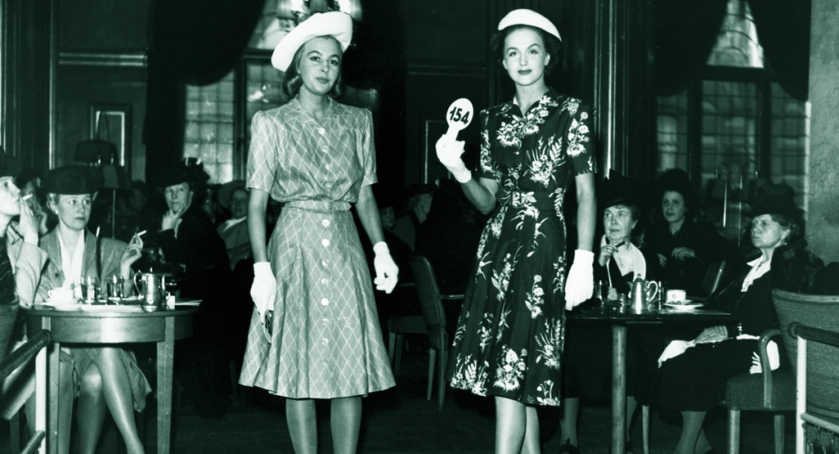
Within the whole sweep of Hjördis Niven’s life, there are many areas of specific interest, such as her marriage to David Niven, her life in Hollywood, her friendship with Princess Grace of Monaco, the careers of her nieces Pia and Mia Genberg, and her years as a fashion model in Sweden.
A girlish daydream
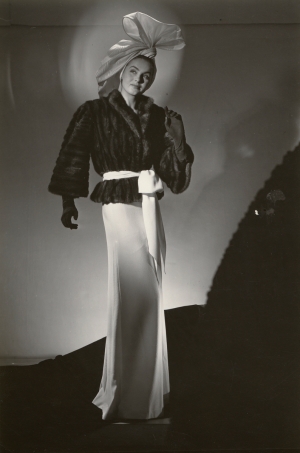
There are many 1941-1945 photos on this site from Hjördis’ time as a model. Still, I thought it would be interesting to group together some contemporary information on the career itself, described in 1960 by UK newspaper The Guardian as “a girlish daydream” just before they proceeded to pop the balloon:
“To spend the day in wonderful clothes, swaying down the runway amid admiring eyes; to be feted and worshipped, and finally to marry a duke or a millionaire – this is the mirage before teenage eyes.”
“The hard facts are quite different. Exhaustion, frustration, jealousy, the realisation that very few ever make the top grade, long periods of unemployment and the eventual relegation to the scrap heap because no other training has been given – these are the ingredients of many a bitter cup drunk by the unsuccessful in any country. And there are moral risks.” [Read on if you dare…]
“There are always those who will take advantage of day-dreamers. The girl who leaves home to pick up the gold on city pavements can still end up in the gutter. Even if she is moderately successful, she may well spend her days in a company that cares little for her welfare, and her private behaviour is probably no one’s concern but her own unless it interferes with work.” [OK, it’s now safe to come out from behind your sofa]
Hjördis’ girlish daydreams did not revolve around modelling, and her marriage fantasies didn’t extend beyond getting hitched to a doctor. Even being ‘discovered’ at 17 to front a brief face-cream promotion doesn’t seem to have sparked any desire for life as a model. Instead, her breakthrough at Nordiska Kompaniet’s Leja store in Stockholm came from answering a job advert – after other career avenues hadn’t worked out. Once accepted, she found that she was a natural.
The Plank becomes Queen of the models

Hjördis’ most significant influence was fellow NK model Kim Andersson. According to Hjördis’ niece Anette, her aunt always considered Kim a special friend.
Kim Andersson was born Elvira Viktoria Andersson on 5th October 1921. She began her modelling career as a sales assistant at the Leja store at a time when fuller figures were in vogue. Her slim-line silhouette earned her the nickname “The Plank” from co-workers. [A variation of “Twiggy”, but twenty years earlier.] However, a manager at the store saw modelling potential, and “The Plank” soon became known as “Queen of the models.”
“Kim Söderlund’s mini-waist brought gasps of envy from the audience,” was how one newspaper looked back on her appearances in Leja fashion shows.
Hjördis and Kim have been referred to as Sweden’s first supermodel. However, Hjördis’ pre-Niven celebrity status peaked in 1946 when she had already given up her career and become Hjördis Tersmeden.
Modelling was a profession that Hjördis was able to navigate with the help of Kim, her Leja manager Gun Stjernström – who took Hjördis into her home and provided motherly care, and from 1943 onwards her new managers at NK Franska:
“My managers, Kurt Jacobsson and (dress designer) Pelle Lundgren, were very kind to me and my colleagues,” Hjördis recalled. “They cared about us and were always willing to assist when we needed help or advice.” Even after her modelling years, Hjördis remained a friend of Pelle Lundgren and his family.
Following Hjördis’ years of incredible success, Kim was Stockholm’s top model, even after her marriage in 1946 when she became Kim Söderlund and started a family. “She loved the work,” a newspaper article gushed, “and when marriage and children ended a full-time career for her, she kept a toe in with freelancing and the setting up of a school for models. And then she suddenly discovered a cause – overhauling the modelling profession.”
No flighty pieces
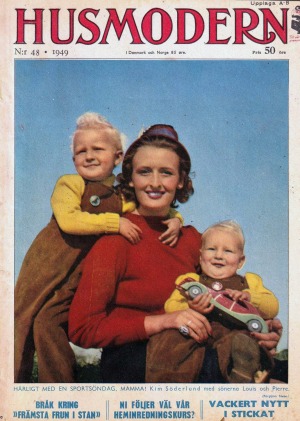
In 1957, Kim set up a modelling school, ‘Kims Stil’, attended by Hjördis’ nieces Pia and Mia Genberg. She also set up The Swedish Mannequins’ Association.
“From the beginning, she had a pretty clear idea of her target. First, recruiting girls who would be a credit to the profession. There were to be no flighty pieces [flighty pieces?], no pretty faces with few wits behind them. Since Swedish models are famous for beauty and poise, they are likely to be in demand in other countries: Kim’s girls had to be those whose good behaviour would make them good ambassadors. They must be educated: they must be properly trained, and they must undertake to abide by the rules of their organisation.”
“Their benefits are the certainty of employment, protected pay rates, advice, contacts, a general eye on their welfare training for superannuation, and the most motherly of eyes from Kim herself. Already [i.e. in 1960], more than 70 per cent of all the models in Sweden belong to her organisation. No longer is the profession looked down upon.”
“They must be real people,” Kim declared, drawing upon the years when she and Hjördis led the way, “ambitious, not only for themselves but for the profession. They must be educated or willing to learn: of good behaviour and poise so that they know how to meet awkward situations. They must be prepared for a year’s apprenticeship to see if they are suited to the work.”
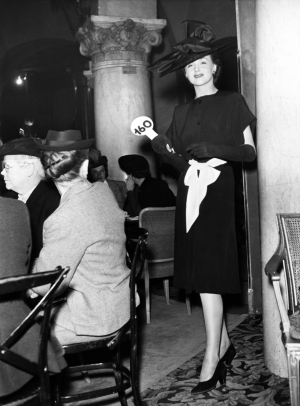
“Their private life must be beyond reproach. The model lives in a showcase. If she has a drink, people say she has had three. So she must learn how to refuse gracefully, and, if she has not acquired old-fashioned standards of modest behaviour at home, must acquire them now.”
“If we have complaints, we investigate them. If they are true, she gets a warning. If there are three warnings, we gently tell her that modelling is not for her. We are always gentle with these girls because we realise how disappointing refusal will be, but we are firm. Our rules apply to all classes of modelling. For instance, we do not recognise photographic work as a lower grade. All the girls work on equal terms, though the rates of pay may vary.'”
As an example of the top pay rates, the “Queen of the Swedish models” in 1955 was Louise Lindkvist, who claimed to be the highest-paid model in the country, earning up to $200 a day ($1900 in 2018). She pointed out that was due to a lot of quick-changing, as models were paid by the dress. During the busy seasons, she was modelling 50 outfits a day at $4 a pull-on.
Gentlemen prefer brunettes
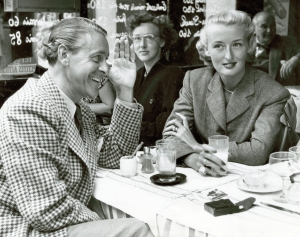
With the home talent looked after, Kim began to branch out into other areas and countries. She became responsible for the training of SAS stewardesses, who were dubiously complimented by The Guardian in 1960:
“Travellers by SAS have noticed the charm and grace of the air hostesses (often quite plain in feature but with an elegance that outweighs mere looks).” [Warning. Do not try that line when trying to get help stowing hand luggage in overhead lockers]
In 1963, Reuters in Stockholm reported: “Sweden is planning to increase one of her most appreciated exports – beautiful long-legged models. Fashion houses and art studios in most Western capitals ask for more and more of these tall, expertly trained girls. The Swedish Mannequins’ Association reports that 50 Swedish girls are modelling in New York. Paris, London, Rome and Zurich. This represents about 20 per cent of the association’s membership.”
“One of the schools, run by a former model, Kim Söderlund, is making plans to develop this potential export market. Mrs Söderlund says she is building up a new system for providing photographers and fashion studios with trained models. She said: ‘I have been running this school for seven years and inspected perhaps 1000 girls a year to be trained. Of these, I choose 10.'”
Another international success for Swedish models was in the film industry. “Swedish girls come from tall, lean stock, and they know all about the fame achieved by compatriots such as Greta Garbo. Ingrid Bergman and Anita Ekberg. So a constant stream of girls flows into Stockholm’s three schools for models.”
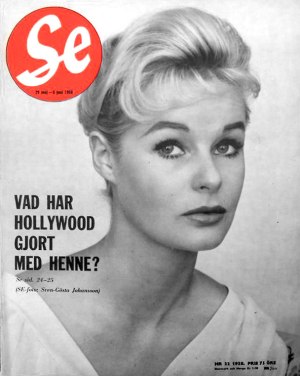
In 1958, actress and model Ingrid Goude told the Ft Lauderdale News how her career began:
“I was seeing a soccer game in Sandviken, and a famous Swedish dress designer was there too. He introduced himself and offered me a job modelling. Always I wear nice clothes, even if they are not mine. So I say yes.”
Ingrid Goude quickly pointed out that it wasn’t her blonde hair that got her noticed: “Hollywood very much likes blondes, but when I was a model in Sweden, I dyed my hair black because, in Stockholm, gentlemen prefer brunettes.” Even Hjördis’ red hair became noticeably darker during her modelling days in Stockholm.
Miss Sweden
Former teen model Anita Ekberg’s movie break came after being crowned Miss Sweden in 1951, and Ingrid Goude was offered a contract when she became Miss Sweden in 1956.
Once in America, Ingrid Goude became aware of differences in makeup. “I was a model in Sweden, and I realise now that I wore too much makeup,” she mentioned in 1957. “It is more flattering when you learn to get the same effect with only a little. And I very much like the pale lipsticks. The shades I used to wear seem too bright and artificial now.” Wearing too much makeup was frequently thrown at Hjördis during her marriage to David Niven.
It’s also worth pointing out that despite a newspaper comment attributed to David Niven Jr. in 2009, Hjördis was not a former Miss Sweden. The contest only began in 1949, when she was already married to David Niven Snr.
Next page: Hjördis Genberg, fashion model. 1945 or get straight on with her story: Hjördis in the city, 1942-1943